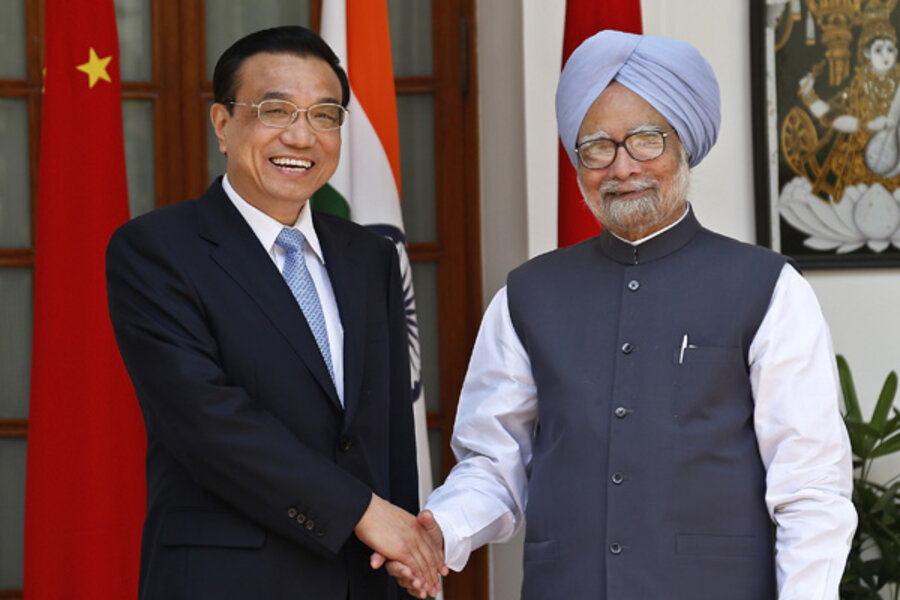Chinese premier visits India, talks up trade and trust
Loading...
| Beijing
China’s leaders never tire of saying it: Asian giants India and China, the two most populous nations in the world, have so much in common that neighborly relations should be natural and fruitful.
But if Chinese Premier Li Keqiang has this week chosen New Delhi as his first foreign destination since taking office in March, it is because such neighborly relations are proving stubbornly difficult to establish.
“India is a very, very significant country for China,” says Hu Shisheng, head of South Asian studies at the China Institutes of Contemporary International Relations in Beijing. “But we suffer from a strategic trust deficit.”
Mr. Li arrived in Delhi on Sunday at the start of a three-day trip designed to rectify that shortfall. “I want this visit to show the whole world that the mutual political trust between China and India is rising, practical cooperation is expanding, and there are more common interests than differences,” he told Indian Prime Minister Manmohan Singh.
What China wants
China is keen to improve its relations with India at the moment for a couple of reasons. First, Beijing does not want to see India align itself more closely with the United States and China's other Pacific rivals like Japan. And India represents a major new market for Chinese infrastructure companies.
The trip has been shadowed, though, by a recent three-week standoff between Indian and Chinese troops on their disputed Himalayan border, in an incident that underlined the two countries’ traditional rivalry.
Home to more than one-third of humanity, China and India are more than just neighbors; both are rising global powers that are still developing countries and which have become strategic partners on many international issues.
Delhi and Beijing find themselves on the same side in global arguments over such questions as climate change, for example, or the reform of the international financial system.
The two sides have also found there is a lot of room to boost their trade, which last year stood at a rather lackluster $66 billion. They have set themselves the target of increasing that to $100 billion by 2015, and of encouraging more cross-border investment. India wants to trade China more pharmaceuticals and information technology. China, meanwhile, has seen India emerge as its biggest market for infrastructure contracts – already worth $35 billion and with $16 billion of deals in the pipeline. With warmer bilateral ties, Beijing hopes, that figure could rise significantly.
But their good intentions are persistently dogged by worries on both sides over security questions.
Before Li left Beijing, the ruling Communist Party’s official mouthpiece, the People’s Daily, published a commentary in its overseas edition saying China and India had agreed to “separate the boundary issue from overall China-India relations and ensure the relevant differences do not affect the development of bilateral ties.”
Future of flare-ups?
But that is easier said than done, suggests Lora Saalman, an expert on Sino-Indian relations at the Carnegie Endowment for International Peace in Beijing. “Putting strategic issues aside to focus only on economic ties means that such flare-ups will continue to erupt,” she warns.
India and China fought a brief border war in 1962; China’s victory still smarts in India and the two sides have never been able to agree on where the nearly 2,500 mile border actually lies. The frontier has remained generally quiet – no shots have been fired for more than half a century – but tense standoffs occasionally blow up and sour bilateral relations.
No resolution of the dispute seems in sight. As both nations rise on the international scene, so do nationalist sentiments in each country. Neither government will find it easy to make the sort of concessions required for a deal.
“The territorial issue is politically highly risky,” says Professor Hu. “Neither party has the guts to find a solution.”
Beijing and Delhi have also yet to overcome historical differences born of the cold war, when India was friendly with the Soviet Union while her bitter enemy, Pakistan, found arms and diplomatic aid in China.
That history complicates current geopolitical frictions, as China and India discover they have overlapping interests.
India today is increasingly close to Washington, a posture that alarms Beijing, and India is rubbing up against China in the South China Sea, where a state-owned Indian oil company has signed an exploration deal with Vietnam in waters that China claims as hers.
The Indian Navy, an admiral warned late last year, is prepared to deploy to the area to defend Indian interests.
China, meanwhile, has unnerved some Indian strategists with its activities in the Indian Ocean. A Chinese company now operates the Chinese-built port at Gwadar, in Pakistan’s Balochistan Province; the Chinese Navy has refueling rights in the Seychelles, and a Chinese-built port in Hambantota, Sri Lanka, is due to open next month.
As China courts India with visions of an economic partnership that could strengthen Asia’s sway over the world economy, Beijing must be careful not to upset Pakistan, to whom it has always been an “all weather friend” in the two allies’ diplomatic parlance.
Li will travel to Pakistan after his Indian visit, dancing a delicate diplomatic minuet as he seeks to strike a better balance between China’s relationships with its two southern neighbors without alarming old friends.
While it is important for China to reassure Pakistan that their “time-tested strategic partnership” is not at risk, says Zhang Li, a South Asian specialist at Sichuan University in the southwestern city of Chengdu, “we have to make Pakistan understand that it is a strategic necessity for China to have balanced relations in South Asia.
“We need credible working relations with India,” Professor Zhang adds. “For that we need to give substance to our partnership, and the first task is to promote mutual trust and confidence.”







